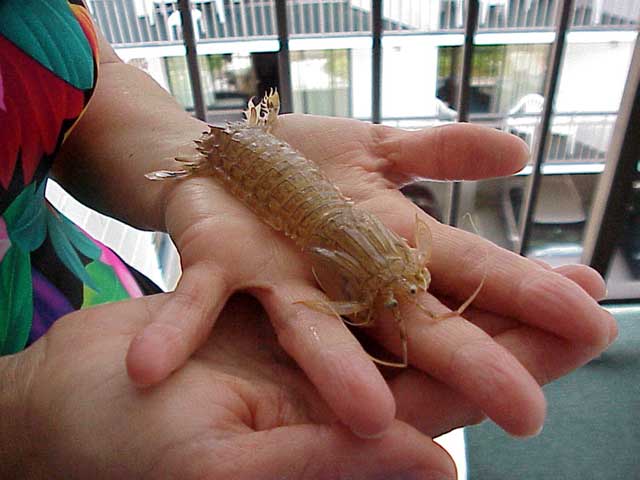


Elbuort was all tuckered out, and it was a good thing. Alive also meant edibility. We had to do something, right? Perhaps drop Elbuort into boiling water? That might make a good snack. With wisdom Daddy cautioned not to eat anything unknown. Nobody knew Elbuort. I've since learned something, in particular three unbeatable traits.
Elbuort--infamous to aquarium keepers and select other living beings, bright or brainless--is TROUBLE spelled backwards. O.k., Elbuort is special. I expected that much, just not how much. In the ocean, Elbuort would wrap around my fingers, holding on to keep from getting swept away by the waves and undercurrents, and when lifted out of the water, weakly tried to swim. Tropical storm Allison had sent Elbuort a one-way trip from home. My hand held this youngster, one of earth's most aggressive and pugnacious creatures, a very late stage larva Squilla empusa, a stomatopod of the subphylum Crustacea and class Malacostraca, from the largest and tremendously diverse class of crustaceans, over 20,000 species!
Called "mantis shrimp" for its preying mantis posture, a stomatopod is not a shrimp but a predatory crustacean related to shrimps, crabs, and roly-polys, the terrestial sowbugs children love to find under rocks in backyards. Divided by function into spearers and smashers (or clubbers), the one I found has a strike speed on the order of 30 feet per second, one of the fastest movements in the animal kingdom. Spring loaded, knife-like spear arms can cut you wide open in 3 milliseconds if you mess with it. In retrospect, it really seems a good thing we were both tuckered out. (The smasher--or clubber--strike approaches the force of a .22 caliber bullet, and has shattered double wall aquarium safety glass.) Stomatopods have extraordinary emerald green eyes and the world's most sophisticated vision, 16 different types of photoreceptors (12 for color analysis vs. our 3 cones). Mantis shrimp see polarized light and 4 colors of ultraviolet light, distinguishing up to 100,000 colors (we see 10,000). Stomatopods have existed worldwide about 200 million years. They are edible, in fact very tasty.
We identified our little sea animal after only three characteristics under:
http://www.crustacea.net/delta/crustace/index.htm
In addition to Webster's Dictionary, we also looked up these three sites:
http://www.blueboard.com/mantis/;
http://www.chesapeakebay.net/info/mantis_shrimp.cfm;
http://leejohnsen.com/stooges/mantis.htm
Read Ruth's Myrtle Beach Travelogue